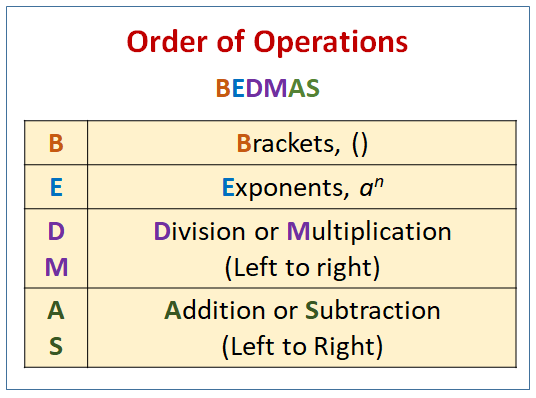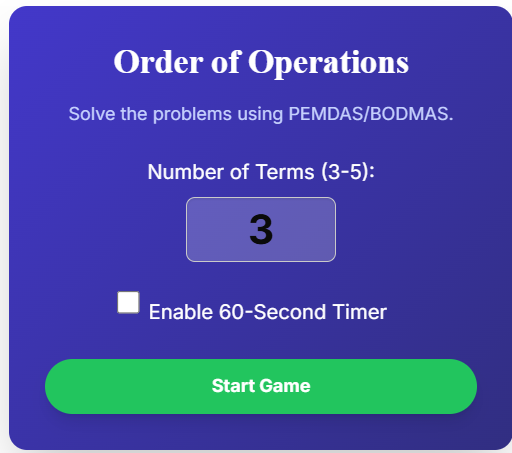Order Of Operations Worksheets - BEDMAS or PEMDAS
What is the BEDMAS rule?
BEDMAS (or PEMDAS) is an acronym used to remember the order of operations in mathematical expressions. It tells you which calculations to perform first when you have a combination of different operations like addition, subtraction, multiplication, division, exponents, and parentheses.
Practice order of operations using BEDMAS (Brackets, Exponents, Division, Multiplication, Addition, Subtraction).
More Order of Operations Worksheets
-
Printable
Order of Operations (introduce parenthesis)
Order of Operations (+, -, ×, parenthesis)
Order of Operations (+, -, ×, ÷, parenthesis)
Order of Operations (+, -, ×, ÷, parenthesis, exponents)Order of Operations (introduce exponents)
-
Online
Order of Operations Game
Order of Operations (+, –)
Order of Operations (parenthesis, +, –)Order of Operations (×, ÷ )
Order of Operations (parenthesis, ×, ÷)Order of Operations (×, ÷, +, –)
Order of Operations (parenthesis, ×, ÷, +, –)
Order of Operations (parenthesis, ×, ÷, +, –)
Objective: I know how to perform mixed operations with brackets or parenthesis, exponents, multiplication, division, addition, and subtraction.
If the calculations involve a combination of brackets or parenthesis, exponents, multiplication, division, addition, and subtraction then you need to follow the BEDMAS rules:
Step 1: First, perform the operations within the brackets or parenthesis
Step 2: Second, evaluate the exponents.
Step 3: Third, perform multiplication and division from left to right.
Step 4: Fourth, perform addition and subtraction from left to right.
The following diagram shows the BEDMAS rules for order of operations.

What BEDMAS Stands For:
- Brackets/Parentheses (B/P): Perform any calculations inside brackets or parentheses first. If you have nested brackets (brackets within brackets), work from the innermost set outwards.
- Exponents/Orders (E): Evaluate any exponents, powers, or roots (like square roots).
- Division and Multiplication (D/M): Perform division and multiplication from left to right. This is important: if both division and multiplication are present, you do whichever comes first as you read from left to right.
- Addition and Subtraction (A/S): Perform addition and subtraction from left to right. Again, if both are present, you work from left to right.
Example:
Calculate 23 – 3 × (8 – 6)
Solution:
23 – 3 × (8 – 6) (perform within brackets or parenthesis)
= 23 – 3 × 2 (evaluate the exponent)
= 8 – 3 × 2 (perform multiplication)
= 8 – 6 (perform subtraction)
= 2
Click on the following image to play the Orders of Operations Game.

Try out our new and fun Fraction Concoction Game.
Add and subtract fractions to make exciting fraction concoctions following a recipe. There are four levels of difficulty: Easy, medium, hard and insane. Practice the basics of fraction addition and subtraction or challenge yourself with the insane level.

We hope that the free math worksheets have been helpful. We encourage parents and teachers to select the topics according to the needs of the child. For more difficult questions, the child may be encouraged to work out the problem on a piece of paper before entering the solution. We hope that the kids will also love the fun stuff and puzzles.
We welcome your feedback, comments and questions about this site or page. Please submit your feedback or enquiries via our Feedback page.